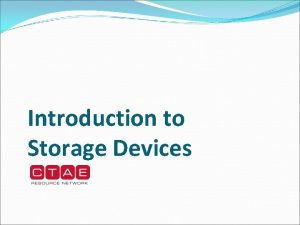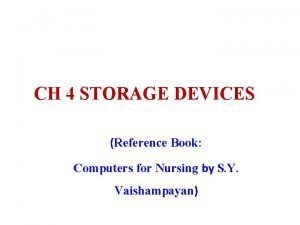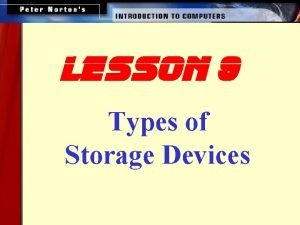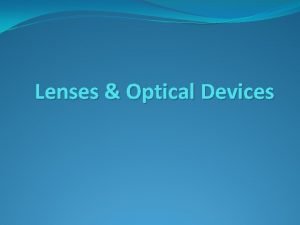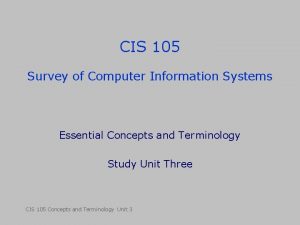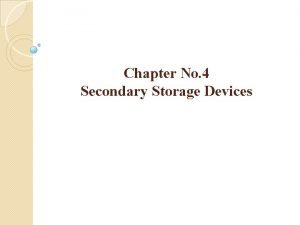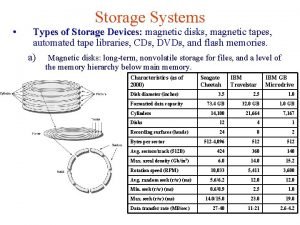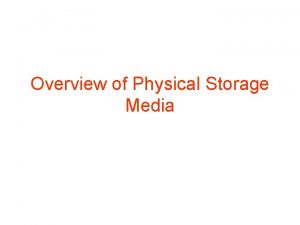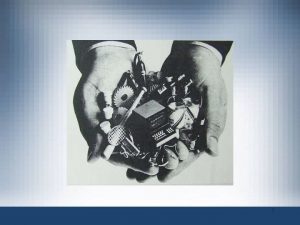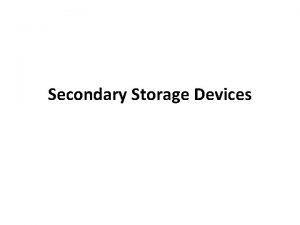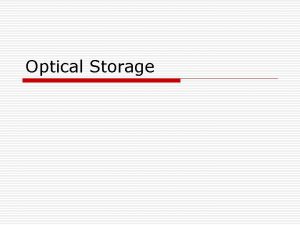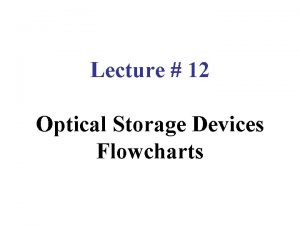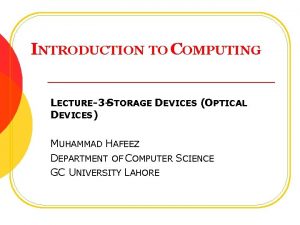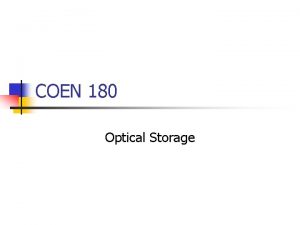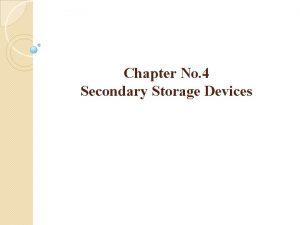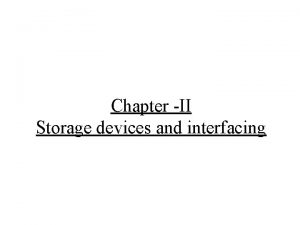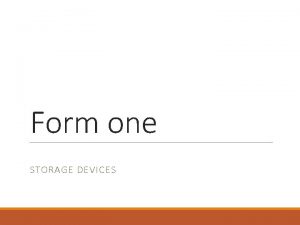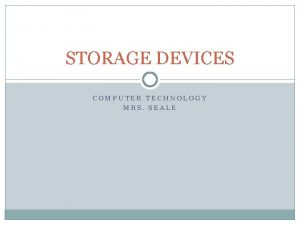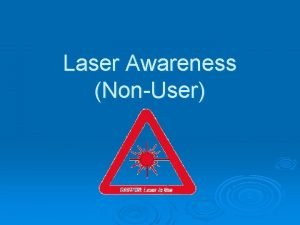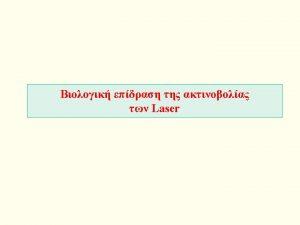Optical storage The storage devices which use laser
















- Slides: 16

Optical storage The storage devices which use laser to read data from or write data to the reflective surface store data optically using laser beam Laser can write and read data at densities much higher than magnetic technology, so the storage capacity of optical disk is much higher than magnetic disk of same physical size Engr: Sajida Introduction to computing

Anatomy of optical disk Optical disk are made of plastic with a reflective metallic or otherwise light-sensitive coating Most O. D are 4. 5 inches in diameter To keep data organized O. D are divided into tracks& sectors but use a single grooved spiral track beginning at the centre of the disk instead of a series of concentric tracks Because lasers can be very precise, the track can be quite narrow and the spiral can be very tight When measured from end to end the total length of the track on a typical CD is over 3 miles No of sectors used varies depending on the size and type of disk Optical disk includes a wide variety of CD, DVD formats and are read by CD or DVD drives Engr: Sajida Introduction to computing

Typically stored in single track Track divided into evenly sized sectors that store items sectors single track spirals to edge of disc Engr: Sajida Introduction to computing

Mechanism CD data is stored as a series of tiny indentations known as “pits”, encoded in a tightly packed spiral track molded into the top of the polycarbonate layer. The areas between pits are known as “lands”. Each pit is approximately 100 nm deep by 500 nm wide, and varies from 850 nm to 3. 5 µm in length. The change in height between pits and lands results in a difference in intensity in the light reflected. By measuring the intensity change with a photodiode, the data can be read from the disc. Engr: Sajida Introduction to computing

The pits and lands themselves do not directly represents the zeros and ones of binary data. A change from pit to land or land to pit indicates a one, while no change indicates a zero. data is stored in the form of lands and pits lands are the flat area of the disk surface and store bit 1 pits are the depression or hollows and store bit 0 Engr: Sajida Introduction to computing

disc label lens pit lens land 0 prism laser diode 1 prism lightsensing diode Engr: Sajida Introduction to computing laser diode lightsensing diode

Step 1. Laser diode shines a light beam toward disc. Step 2. If light strikes a pit, it scatters. If light strikes a land, it is reflected back toward diode. Step 3. Reflected light is deflected to a light-sensing diode, which sends digital signals of 1 to computer. Absence of reflected light is read as digital signal of 0. Engr: Sajida Introduction to computing

Standard CDs are available in size. By far the most common is 120 mm in diameter, with a 74 or 80 -minute audio capacity and a 650 or 700 MB data capacity Engr: Sajida Introduction to computing

Types of CDs DVDs Read only Disks CD-ROM and DVD-ROM CD-ROM Data can not be erased , changed or added Data on a CD-ROM is stored by burning tiny depression (called pits) in to disc surface with a high density laser beam CD ROM drives can play audio CDs and Data CDs The part of the disk that are not changed are called lands Disc is read by a lower density laser beam inside the CDROM drive based on the reflection of light from the disk as it hits the pits and lands the 1 s and 0 s can be determined Engr: Sajida Introduction to computing

Typically holds 650 MB to 1 GB Commonly used to distribute multimedia and software Engr: Sajida Introduction to computing

DVD-ROM (Digital video disk Read only Memory) Must have DVD-ROM drive or DVD player to read DVD-ROM Stores databases, music, complex software, and movies Similar to CD ROM disc , but have a higher storage capacity Contain 4. 7 GB to 17 GB of data Engr: Sajida Introduction to computing

Recordable optical discs The process of recording data on to the disk is called burning Rewritable optical disc CD-RW DVD+RW DVD-RAM Blue Laser Discs Engr: Sajida Introduction to computing

Solid-state Storage Devices Not use disk or tapes and have no moving parts Neither magnetic nor optical It relies on integrated ckt to hold data Some are non volatile and other are volatile Depends on memory it uses Solid state devices have a big advantage over standard devices Speed , Memory devices can move data in much less time than any mechanical storage device this is because solid state devices have no moving parts and because they already store data electronically Engr: Sajida Introduction to computing

Flash memory media Consists of chips and other circuitry that don’t move within the drive as its being accessed Flash memory devices and media are very small use much less power than conventional drives Used in digital cameras, digital music players, handheld PCs smart phones and other type of portable devices Engr: Sajida Introduction to computing

File system In computing, a file system (often also written as filesystem) is a method for storing and organizing computer files and the data they contain to make it easy to find access them File systems may use a data storage device such as a hard disk involve maintaining the physical location of the files Engr: Sajida Introduction to computing

Most file systems make use of an underlying data storage device that offers access to an array of fixedsize blocks, sometimes called sectors, generally a power of 2 in size (512 bytes or 1, 2, or 4 Ki. B are most common). The file system software is responsible for organizing these sectors into files and directories, and keeping track of which sectors belong to which file and which are not being used. Most file systems address data in fixed-sized units called "clusters" or "blocks" which contain a certain number of disk sectors (usually 1 -64). This is the smallest logical amount of disk space that can be allocated to hold a file. Engr: Sajida Introduction to computing
 Secondary storage devices that use laser technology
Secondary storage devices that use laser technology Book
Book Types of optical storage
Types of optical storage Optical devices
Optical devices Storage device that uses laser technology
Storage device that uses laser technology Daisy wheel printer
Daisy wheel printer Literary device scanner
Literary device scanner Primary storage and secondary storage
Primary storage and secondary storage Primary storage and secondary storage
Primary storage and secondary storage Secondary storage provides temporary or volatile storage
Secondary storage provides temporary or volatile storage Object based and unified storage
Object based and unified storage Memoryqq
Memoryqq Secondary storage devices
Secondary storage devices What is physical storage media
What is physical storage media Hardware output
Hardware output Types of storage devices
Types of storage devices Magnetic tape in secondary memory
Magnetic tape in secondary memory
